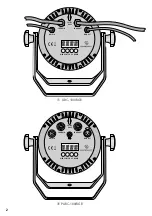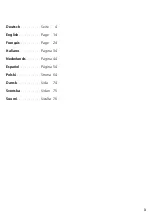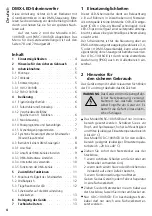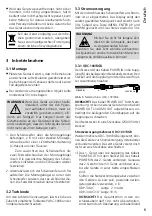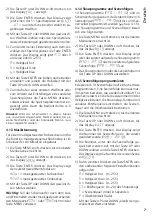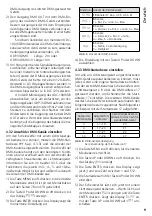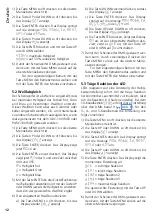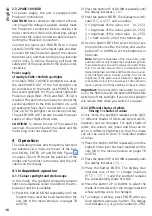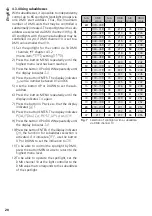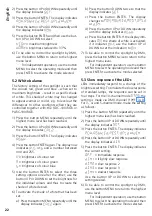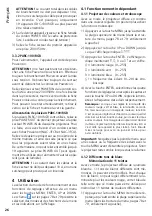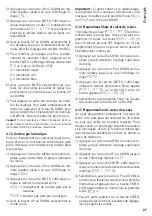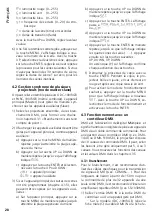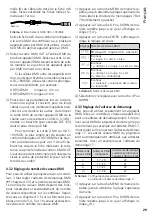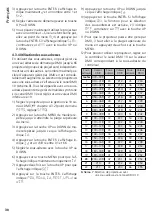
16
English
3.3.2 PARC-100 / RGB
For power supply, the unit is equipped with
Power con connections .
CAUTION!
Never connect or disconnect a Power-
con plug while voltage is applied . Always make
the Powercon connection before making the
mains connection . When disconnecting, always
disconnect the mains connection before discon-
necting the Powercon connection .
Connect the mains jack POWER IN to a mains
socket (230 V/ 50 Hz) via the mains cable provided .
Connect the blue Powercon plug of the cable to
the mains jack, and then turn the plug clockwise
until it locks . To remove the plug, pull back the
safety latch of the plug and turn the plug counter-
clockwise .
Power supply
of multiple PARC-100 / RGB spotlights
If multiple PARC-100 / RGB spotlights are used,
the jack POWER OUT of the first spotlight can
be connected to the mains jack POWER IN of
the second spotlight . For this, a mains cable with
Powercon plugs (NAC-3FCB and NAC-3FCA) is
required . Proceed in the same way to connect the
second spotlight to the third spotlight etc . until
all spotlights have been connected in a chain .
Thus, up to 19 spotlights can be interconnected .
The jack POWER OUT can also be used for power
supply of other (light effect) units .
CAUTION!
To reduce the risk of fire caused by
overload, the current load of the cables and the
mains plug must not exceed 10 A .
4 Operation
The operating modes and the setting functions
are selected via a menu by means of the but-
tons MENU, ENTER, UP and DOWN . Figure 14
on pages 78 and 79 shows the selection of the
modes and functions via the menu and the indi-
cations on the display .
4.1 Independent operation
4.1.1 Colour spotlight and stroboscope
In this mode, the spotlight constantly radiates
light of an adjustable colour . In addition, the stro-
boscope function is available .
1) Press the button MENU repeatedly until the
highest menu level has been reached (on the
very left in the menu structure on pages 78
and 79) .
2) Press the button UP or DOWN repeatedly until
the display indicates
.
3) Press the button ENTER . The display now indi-
cates , , or
and a number .
= brightness of the colour red
(0 – 255)
= brightness of the colour green (0 – 255)
= brightness of the colour blue (0 – 255)
= flash rate (0 – 20) of the stroboscope
4) Use the button ENTER to select the four set-
ting options one after the other, and use the
button UP or DOWN to set the brightness or
flash rate .
Note:
Setting the brightness of the colours red, green
and blue will not only change their brightness but also
the shade of colour in case the colours are mixed . There-
fore, first set the colour which is to dominate to the
desired brightness and then add the other two colours .
If the intended colour mixture is white, first set the
brightness of the green colour because it appears as
the brightest colour to the human eye . Then add red to
result in yellow and finally add blue to result in white .
Important:
Do not exit the menu item for a col-
our or the flash rate with the button MENU before
switching off the spotlight . If you do, the spotlight
will remain dark when you switch it on again .
4.1.2 Different shades of white
Storing 11 shades of colour
In this mode, the spotlight radiates white light .
11 different shades of white are stored which,
however, can be changed . For each shade of
white, the colours red, green and blue can be
set to a different brightness so that this mode
can also be used to store 11 individual shades
of colour .
1) Press the button MENU repeatedly until the
highest menu level has been reached (on the
very left in the menu structure on pages 78
and 79) .
2) Press the button UP or DOWN repeatedly until
the display indicates
.
3) Press the button ENTER . The display now
indicates one of the 11 storage locations
(
…
) and the spotlight radiates
the corresponding shade of white .
4) Press the button UP or DOWN to select the
shade of white desired or the storage locations
whose settings are to be changed .
5) To change a setting, press ENTER after you
have selected a storage location . The display
now indicates , or and a number (0 – 255) .
Summary of Contents for ODC-100/RGB
Page 77: ...77...

